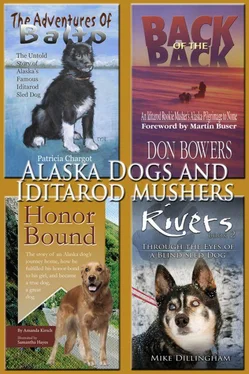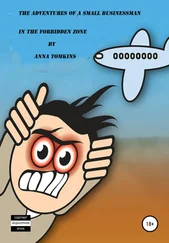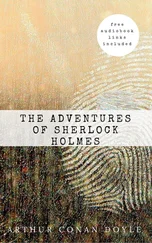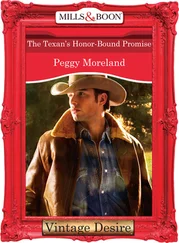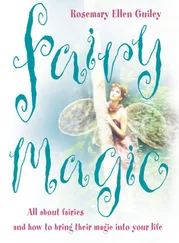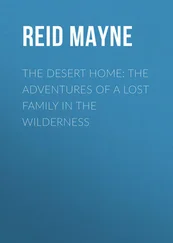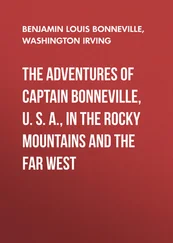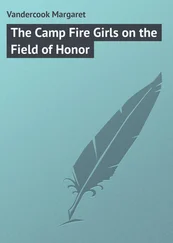My first impression is, “Been here, done this, got the T-shirt.” This is an eerie recreation of my troubles on the Iditarod, when I let a few dogs in heat precipitate everything into the toilet. The musher with whom we’ve knotted up gets his dogs straightened out and then says he’s going to turn around and scratch. I decide there’s no way I’m going back; if I don’t work through this I’m no better off than I was eight months ago.
After 20 minutes untangling and swapping around half a dozen dogs, I’ve got things sorted out. Wild Thing with her feminine wiles is back in wheel where nobody can get at her and old Buck is up front in place of Pullman. Now he has a chance to show his stuff, and show it he does. He starts us off smartly and the remaining 30 miles turn into nothing more eventful than a normal training run. We’ve sacrificed half an hour, but we don’t lose any more. Buck storms across the finish line at a dead run, looking good all the way.
I get the red lantern, but my overall time is a surprisingly fast six hours and 15 minutes for both days, for a very respectable 10 miles an hour. Had we not spent so much time stopped, we’d have had the same time as yesterday. I couldn’t be more pleased with my team. They’ve performed exactly as we’ve trained and Buck has shown he’s just as good as I’d hoped. Moreover, bouncy little Maybelline has been the co-leader all the way on both days. She’s a natural up front, setting a terrific pace and generally having more fun than the law allows. I hope John Barron doesn’t want her back — she’s a keeper and I can guarantee she’ll get her share of leading on the races to come.
As I herd the dog truck back down the narrow, snow-covered road in the deepening four-o’clock dusk, I feel tired but relieved; this has been my first red lantern, but I couldn’t be happier with it. I may not have a world-class team, but the dogs certainly look solid enough to hold their own. If they don’t make it to Nome this time, it won’t be their fault.
December 24, 1995
Montana Creek, Alaska
Christmas Eve again, and not a lot going on. The lack of good snow throughout much of Southcentral Alaska seems to be having a depressing effect on everyone, especially mushers. Aside from the Forks Roadhouse race a few days ago, there’s nothing on the horizon for weeks except going round and round on our local trails as long as our scant snow cover holds out..
The Knik 200 has been postponed; the race follows the Iditarod Trail out to Skwentna, but the trail is bare dirt for the first 20 miles, from Knik out past the Little Susitna River. Worse, the Yentna River — which is the entire far half of the race — is threatening to become one huge lake of overflow because very thick ice has frozen the mouths of side streams all the way to the bottom in places, forcing them to flow out over the top of the river ice.
This could have major ramifications for the Klondike 300 on January 20th (which I plan to run) and for the Iditarod in March because they use the same trail as far as Skwentna. Ron says he remembers a winter in the late 1960s that froze early and hard with very little snow; the Yentna was completely impassable to dog teams for almost 40 miles because of overflow, and other rivers weren’t much better. Odds are we will have enough snow to run the Iditarod, even if the route has to detour overland to avoid the river, but early races may be postponed until February. This will make for a very hectic race season, and some of the rookies who have to qualify may be out on a limb unless the Iditarod relaxes the qualification requirements.
Our local trails are still in reasonably good shape so I decide to hook up 12 dogs and hit the trail about sunset. I feel being out with the team is the best way I can celebrate the occasion, and besides, they need the miles. After a few pauses in the initial mile or two to straighten out some minor rigging problems and to swap Socks for Pullman in lead (she’s in heat and is getting moody), we make very creditable time around the 20-mile loop. As we reach the turnoff for the dog lot, I decide everything is going so smoothly we might as well keep going for 30 miles. Socks seems a little surprised when I give him a “haw” instead of a “gee” but as soon as we’re steady on the outbound trail everybody speeds up smartly.
After a mile we come to a particularly tricky part of the trail, requiring the team to jump up over a two-foot bank while the musher adroitly levers the sled up behind them. I miss the bank and the sled flips. It’s not a big thing, but I’m upset at screwing up and jump off to pull the sled up the bank. The dogs, of course, do their best to help, and as soon as I get it started over the lip they yank it several feet, pinning me under it with my foot twisted in the bridle at the front of the sled. I try to turn the sled on its side but I can’t get the correct angle, and the dogs yank again. This time my foot gets caught in the brake at the back of the sled while the rear runners pin me flat on the ground.
I’m worried my ankle is about to be badly sprained and there’s nothing I can do about it. As I make one last effort to tip over the sled and get out from under it, Socks starts the team and I pop free. Unfortunately, Socks is heading one way and I’m pointed another, and as I stagger to my feet the team and sled are 20 yards down the road and moving fast. There’s no hope of catching them. I’ve done it again: my Christmas present to myself is to lose the team.
I’m so mad I feel like chewing tree bark. However, I have a secret weapon for just such a development — my cellular phone. I fish it out of my parka pocket and call Ron’s place; to my frustration, he’s not there, but I leave a message to head the team off if he can. I have to assume Socks will take everybody back to the lot; he knows the way well enough. We’re only about five miles from home and my only worry is the sled will spill or overrun the wheel dogs on a hill, or there will be a tangle and a dog will be hurt. But for the meantime, there’s not much to do but hoof it.
Last year when I lost the team I was worried about them getting lost or heading out to the highway; this year that doesn’t bother me, but my own stupidity does. I knew better than to let go of the quick-release rope, which I wrap around my wrist as a safety line; I’ve always considered getting dragged behind the sled to be much preferable to losing the team. But I was getting irritated at myself and forgot some fundamental procedures. At the least, I could have set the snow hook, which would probably have prevented the team from pulling away so quickly.
It takes me an hour to walk back. As I near the lot, Ron meets me and says the team was waiting patiently in the driveway with only a minor tangle or two. As usual, Socks has brought everybody home in one piece, except for me. Ron even comments on how orderly the dogs are; just like last year, I have to pat myself on the back for training them well even as I kick myself in the rear for losing them in the first place. Ron just laughs and says any experienced dog driver who hasn’t walked home a few times is doing something wrong.
I go inside and stew for awhile, contemplating the possibility of hitching everybody up and going out again. But I know the dogs didn’t do anything wrong and I wouldn’t be proving a thing to take it out on them. So I decide to give myself a real present and hop in the car and run over to Steve Adkins’ place. He’s offered me a deal I can’t refuse on one of the best leaders in this part of the state.
I’ve temporarily got a decent bank balance because I’ve just sold my airplane. Of course, this is the same one I used to fly for the Iditarod and which was the vehicle to get me interested in running the race in the first place; O. Henry would have loved the whole affair, I think. Anyway, I happily write Steve a check for Lucky, whom Steve ran in the 1994 Iditarod; as I sign it I think this is infinitely better than shopping till I drop in one of the malls in Anchorage for stuff I’d just lose or put on a shelf after a few months.
Читать дальше
